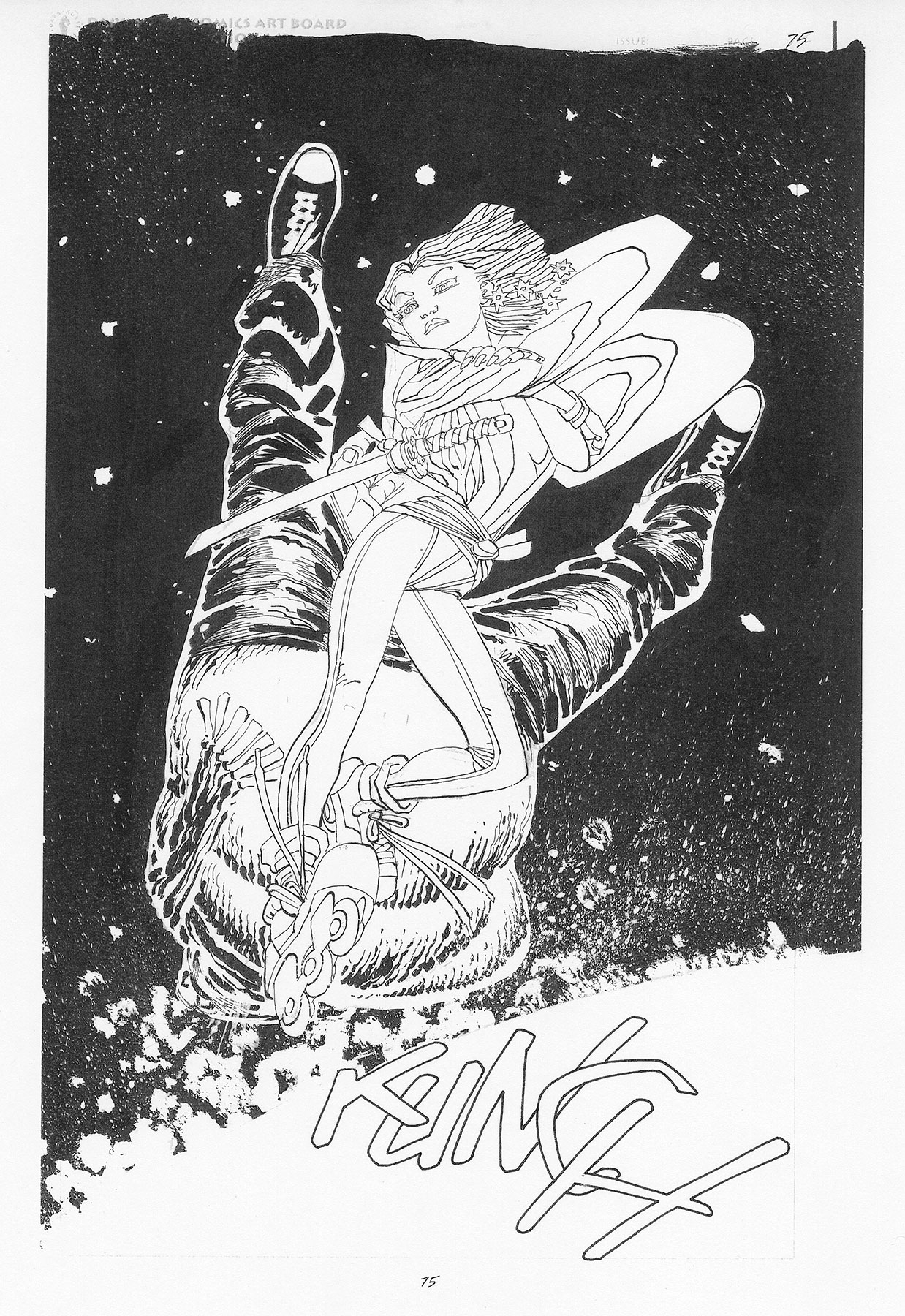So, here we are talking about Frank Miller, a name that echoes through the halls of comic book history like a thunderclap. If you're into comics or even just pop culture, you've probably stumbled across his work whether you know it or not. This dude didn't just write comics; he redefined the entire medium, bringing dark, gritty storytelling to the forefront. His influence is felt everywhere, from the pages of Batman to the silver screen. So, strap in, because we're diving deep into the world of Frank Miller, and trust me, it's gonna be a wild ride.
Let's get one thing straight: Frank Miller isn't just another comic book writer. He's a legend, a guy who took the superhero genre and flipped it on its head. Imagine a world where Batman isn't just a guy in a cape fighting crime but a complex, flawed hero grappling with his own demons. That's the world Frank Miller created, and it's a world that resonates with readers to this day. His work isn't just about superheroes; it's about humanity, morality, and the gray areas in between.
But enough with the hype, right? Let's break it down. Why does Frank Miller matter? Why should you care about his work? Because his stories aren't just tales of capes and cowls; they're reflections of our own struggles, fears, and hopes. They're stories that challenge us, that make us think, and that's what makes them so damn powerful. So, whether you're a comic book veteran or just curious about the guy behind some of the biggest stories in pop culture, you're in the right place.
Read also:From Boy Band Sensation To Solo Success Liam Paynes Remarkable Journey
Biography of Frank Miller: The Early Years
Frank Miller wasn't born with a pen in his hand, but you'd think so given how much he's achieved. Born on January 27, 1957, in Olney, Maryland, Miller grew up in a world where comics were more than just entertainment; they were an escape. His parents were teachers, and while they weren't exactly comic book enthusiasts, they encouraged his love for storytelling. As a kid, Miller devoured everything from Superman to EC Comics, the latter of which had a significant impact on his later work.
School wasn't exactly Miller's thing, but art was. He spent hours drawing and writing, honing his skills and dreaming of the day he'd create his own comics. By the time he was in high school, he was already submitting work to local publishers, and though he didn't get much traction back then, it was the start of something big. His early years were filled with passion and determination, two traits that would define his career.
A Quick Glimpse at Frank Miller's Personal Data
Here's a quick rundown of Frank Miller's personal info:
| Full Name | Frank John Miller |
|---|---|
| Date of Birth | January 27, 1957 |
| Place of Birth | Olney, Maryland, USA |
| Occupation | Comic Book Writer, Illustrator, Filmmaker |
| Notable Works | The Dark Knight Returns, Sin City, 300, Batman: Year One |
Breaking Barriers: Frank Miller's Rise in the Comic Book World
So, how does a kid from Maryland go from doodling in notebooks to revolutionizing the comic book industry? Well, it wasn't easy, but Miller had talent, and talent has a way of making itself known. In the late '70s, he started working for Marvel Comics, contributing to titles like Shogun Warriors and Wolverine. But it wasn't until he took over Daredevil that people really started paying attention.
With Daredevil, Miller didn't just tell stories; he crafted masterpieces. He introduced new characters, like Elektra, and turned Matt Murdock's world upside down. The series was darker, more mature, and it resonated with readers in a way that few comics had before. It was a turning point not just for Miller but for the entire industry. Comics weren't just for kids anymore; they were for everyone.
Key Contributions to Comic Book Storytelling
Miller's work on Daredevil set the stage for everything that came after. Here are some of his key contributions:
Read also:David Coverdale Age Insights A Deep Dive Into The Legendary Rock Stars Life And Career
- Dark Themes: Miller wasn't afraid to tackle tough subjects, from corruption to redemption.
- Complex Characters: His heroes weren't perfect; they were flawed, relatable, and real.
- Innovative Storytelling: Miller pushed the boundaries of comic book narratives, experimenting with structure and style.
The Dark Knight Returns: Frank Miller's Magnum Opus
Let's talk about the big one, folks. The Dark Knight Returns isn't just a comic; it's a cultural phenomenon. Published in 1986, it redefined Batman and, by extension, the entire superhero genre. Miller's take on the Caped Crusader was brutal, raw, and unapologetically dark. It was a story about an aging Batman coming out of retirement to fight crime in a world that had moved on without him. Sound familiar? That's because it's been copied countless times since, but Miller did it first, and he did it best.
What made The Dark Knight Returns so special was its depth. It wasn't just a story about a guy in a bat suit; it was a commentary on society, power, and the cost of heroism. The art, courtesy of Klaus Janson and Lynn Varley, was stunning, and the writing was sharp, intelligent, and thought-provoking. It's no wonder it's considered one of the greatest comic book stories of all time.
Legacy of The Dark Knight Returns
The impact of The Dark Knight Returns can't be overstated. Here's how it influenced the industry:
- Inspired a New Generation: Countless writers and artists cite it as a major influence.
- Changed Batman Forever: The gritty, no-nonsense Batman we know today owes a lot to Miller's vision.
- Crossed Over to Other Media: The story has been adapted into animated films, video games, and more.
Frank Miller's Sin City: A Graphic Novel Revolution
But wait, there's more! After The Dark Knight Returns, Miller didn't rest on his laurels. Instead, he created Sin City, a series of graphic novels that pushed the boundaries of what comics could be. Set in a dark, noir-inspired world, Sin City was unlike anything readers had seen before. Its stark black-and-white art style, courtesy of Miller himself, was striking, and its stories were brutal, violent, and unflinching.
What made Sin City so compelling was its characters. You had anti-heroes like Marv, Dwight, and Nancy Callahan, all of whom were flawed, complex, and deeply human. The series wasn't just a story; it was an experience, one that left a lasting impression on readers.
Impact on the Graphic Novel Industry
Sin City wasn't just a success; it was a game-changer. Here's why:
- Pushed Artistic Boundaries: Its unique visual style inspired countless artists.
- Expanded the Medium: It showed that graphic novels could be more than just superhero stories.
- Crossed Over to Film: The adaptation, directed by Robert Rodriguez and Miller himself, was a hit.
Frank Miller's Batman: Year One
Let's talk about another classic: Batman: Year One. Co-written with David Mazzucchelli, this story redefined Batman's origin. It wasn't just about a rich guy in a cape; it was about a man struggling to find his place in a broken world. The art was stunning, the story was gripping, and the characters were unforgettable. It's no wonder it's considered one of the best Batman stories ever told.
What made Batman: Year One so special was its focus on character development. We see Bruce Wayne's transformation from a scared, inexperienced vigilante to the Dark Knight we know and love. It's a story about growth, resilience, and the unyielding pursuit of justice.
Why Batman: Year One Matters
Here's why Batman: Year One is so important:
- Reimagined Batman's Origin: It gave readers a fresh take on a classic story.
- Set the Tone for Future Stories: Its influence can be seen in countless Batman tales.
- Collaborative Success: The partnership between Miller and Mazzucchelli was magic.
Frank Miller's 300: A Historical Epic
Let's switch gears for a moment and talk about 300. This graphic novel, based on the Battle of Thermopylae, was another masterpiece from Miller. It wasn't a comic book in the traditional sense; it was a visual epic, a retelling of history through Miller's unique lens. The story was brutal, the art was breathtaking, and the impact was massive.
300 wasn't just a success; it was a phenomenon. It was adapted into a film that became a box office hit, and its influence can be seen in countless other works. It was a testament to Miller's ability to take any subject and turn it into something extraordinary.
Legacy of 300
Here's how 300 left its mark:
- Inspired a New Wave of Historical Comics: It showed that history could be just as exciting as superheroes.
- Successful Film Adaptation: The movie was a hit and introduced Miller's work to a new audience.
- Visual Innovation: Its art style was unique and influential.
Frank Miller's Influence on Modern Comics
So, what's the big deal about Frank Miller, anyway? Well, his influence is everywhere. Modern comics owe a lot to Miller's work. His focus on dark, mature themes and complex characters has become the norm, and his innovative storytelling techniques have inspired countless creators. Without Miller, the comic book industry would look very different today.
But Miller's influence extends beyond comics. His work has influenced films, TV shows, video games, and more. His ability to craft compelling stories that resonate with audiences has made him a household name in the world of entertainment.
Why Frank Miller Matters Today
Here's why Frank Miller is still relevant:
- Continued Influence: His work continues to inspire new generations of creators.
- Cultural Impact: His stories have become part of pop culture.
- Timeless Themes: His exploration of morality, power, and humanity is as relevant today as it was when he first wrote it.
Challenges and Criticisms: The Dark Side of Frank Miller
Of course, no one is perfect, and Miller has faced his share of criticism. Some have accused him of promoting toxic masculinity, while others have criticized his political views. It's important to acknowledge these criticisms and understand that even legends are human.
Despite the criticism, Miller's contributions to the industry can't be denied. His work has left an indelible mark on comics and pop culture, and his influence will continue to be felt for years to come.
Addressing the Criticism
Here's how to approach the criticism:
- Contextualize His Work: Understand the time and place in which it was created.
- Separate Art from Artist: Appreciate the work while acknowledging its flaws.
- Encourage Dialogue: Use criticism as a starting point for meaningful conversations.
Conclusion: Frank Miller's Enduring Legacy
So, there you have it, folks. Frank Miller isn't just a comic book writer; he's a visionary, a guy who changed the game and left an indelible mark on the


